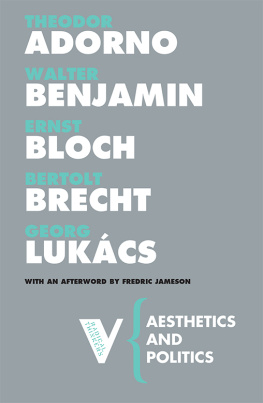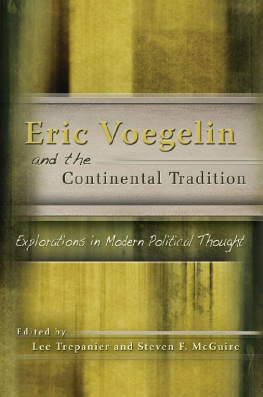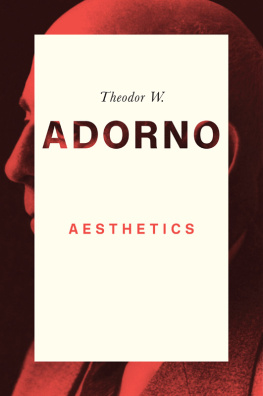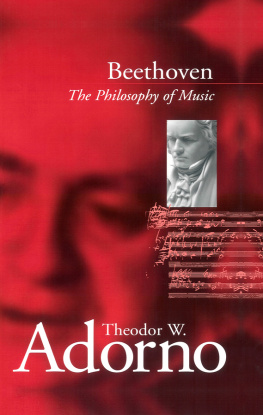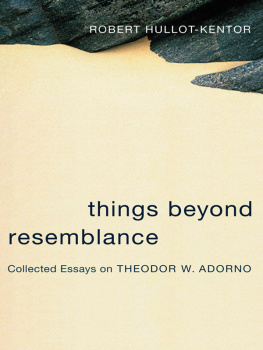Philosophers on Art
from Kant
to the Postmodernists
| Philosopherson Art | Edited by |
| from Kant | Christopher Kul-Want |
| to the Postmodernists |
| A Critical Reader |

Columbia University Press
New York
Columbia University Press
Publishers Since 1893
New York Chichester, West Sussex
cup.columbia.edu
Copyright 2010 Columbia University Press
All rights reserved
E-ISBN 978-0-231-52625-8
Library of Congress Cataloging-in-Publication Data
Philosophers on art from Kant to the postmodernists: a critical reader / edited by Christopher Kul-Want.
p. cm.
Includes bibliographical references and index.
ISBN 978-0-231-52625-8 (cloth: alk. paper)ISBN 978-0-231-14095-9 (pbk.: alk. paper)
1. Aesthetics. 2. ArtPhilosophy. 3. Philosophy, Modern. I. Want, Christopher.
BH39.P47175 2010
701dc22
2009042784
A Columbia University Press E-book.
CUP would be pleased to hear about your reading experience with this e-book at .
References to Internet Web sites (URLs) were accurate at the time of writing. Neither the author nor Columbia University Press is responsible for Web sites that may have expired or changed since the book was prepared.
For Catherine
and Enna Thea
Contents
This book is for those who want to know what philosophers have said about art and how their ideas relate historically and conceptually. At the books core is the ongoing challenge that Immanuel Kant has bequeathed not just to philosophy but also to thinking and theoretical writing in his declaration that art is not an object of knowledge. For those European philosophers writing in the wake of Kants legacy, this thesis has entailed a completely new orientation toward the nature of aesthetic experience, since this may affect not just approaches to art but also the conception of subjectivity itself.
Exploring this legacy this book brings together a compilation of the seminal texts on aesthetics and art by Continental philosophers from the past two and half centuries whose thought has been challenged yet shaped by arts incommensurability with recognized orders of knowledge. The contents and organization of the book draw a great deal upon my experience of teaching postgraduate students at Byam Shaw School of Art at Central St. Martins College of Art and Design, University of the Arts, London. I am very grateful to my colleague Clive Hodgson for highlighting the keen desire that art students possess to engage with philosophy when we established the masters course at Byam Shaw School of Art ten years ago. This book owes much to the enthusiasm of my students to the subject of philosophers on art that forms the nucleus of the masters seminar program at Byam Shaw. I believe this strong response has arisen in part from the fact that while philosophy has its own forms and expression, nevertheless, it has deeply shared concerns and interests for those who make art. Among other things, these revolve around issues of resolution and completion with regard to the work of art and the possibility of transformation in the face of doubt, and even failure.
Bringing this book to fruition has entailed extensive correspondence with publishers copyright departments, and I am very grateful for their assistance in securing copyright for the books texts. Jane Gibb and Professor Martin Woolley of the research department at Central St. Martins have also been extremely helpful in securing several grants from the college to help pay for copyright purchases. I very much appreciate the support of the principal of my college, Alister Warman, who granted me a terms sabbatical leave to research this book. I would like to thank my editors, Wendy Lochner and Christine Mortlock at Columbia University Press, for their advice in the writing and organization of this book. In addition, I thank Simo Costa and Gregory McNamee for their very able assistance in editing and formatting the manuscript. My particular thanks are to my partner Catherine for her support throughout the realization of this project.
Texts in the following chapters are taken from these sources, listed by the authors last name: Theodor W. Adorno, Aesthetic Theory, edited by Gretel Adorno and Rolf Tiedemann, copyright 1997 by the University of Minnesota; Giorgio Agamben, The Man Without Content, copyright 1999 by the board of Trustees of the Leland Stanford Jr. University; Alain Badiou, Art and Philosophy from Handbook of Inaesthetics, copyright 2005 by the board of Trustees of the Leland Stanford Jr. University for the English translation, 1998 Editions du Seuil; Roland Barthes, Camera Lucida: Reflections on Photography, translated by Richard Howard, translation copyright 1981 by Farrar, Straus & Giroux, Inc., reprinted by permission of Hill & Wang, a division of Farrar, Straus & Giroux; Georges Bataille, Visions of Excess: Selected Writings, 19271939, translated by Allan Stoekl, with Carl R. Lovitt and Donald M. Leslie Jr., copyright 1985 by the University of Minnesota; Walter Benjamin, One-Way Street and Other Writings, copyright granted by permission of Verso; Gilles Deleuze, Francis Bacon: The Logic of Sensation, copyright 2002 Les Edition du Seuil, English translation copyright Continuum International Publishing Group Ltd.; Jacques Derrida, Spurs: Nietzsches Styles, copyright granted by permission of University of Chicago Press; Michel Foucault, The Order of Things, Copyright 1970 by Random House, Inc., New York, copyright 1966 by Editions Gallimard, reprinted by permission of Georges Borchardt Inc. for Editions Gallimard; Sigmund Freud, Beyond the Plea sure Principle, translated by James Strachey, copyright 1961 by James Strachey, used by permission of Liveright Publishing Corporation; Sigmund Freud, Leonardo Da Vinci and a Memory of His Childhood, translated by Alan Tyson, copyright 1957 by The Institute of Psycho-Analysis, used by permission of W. W. Norton & Company, Inc., and Taylor & Francis Books UK; Martin Heidegger, Basic Writings, revised and expanded edition, edited by David Farrell Krell, English translation 1977, 1993 by HarperCollins Publishers Inc.; Martin Heidegger, Nietzsche, The Will to Power as Art, translated by David Farrell Krell, copyright 1979 by Harper & Row Publishers Inc.; Immanuel Kant, Critique of Judgment, trans. Werner Pluhar, 1987, reprinted by permission of Hackett Publishing Company, Inc.; Jacques Lacan, The Four Fundamental Concepts of Psycho-analysis, translated by Alan Sheridan, English translation copyright 1977 by Alan Sheridan, used by permission of W. W. Norton & Company, Inc., and the Random House Group Ltd.; Jacques Lacan, crits: A Selection by Jacques Lacan, used by permission of W. W. Norton & Company, Inc., and Taylor & Francis Books; Jean-Franois Lyotard, Innovation / Renovation by Ihab Hassan, 1983, reprinted by permission of the University of Wisconsin Press; Jean-Luc Nancy, The Muses, copyright for the translation 1996 by the Board of Trustees of the Leland Stanford Jr. University, 1994 by ditions Galile; Friedrich Nietzsche, The Portable Nietzsche, edited by Walter Kaufman, translated by Walter Kaufman, copyright 1954 by the Viking Press, renewed by 1982 by Viking Penguin Inc., used by permission of Viking Penguin; Friedrich Nietzsche, The Will to Power, edited by R.J. Hollingdale, translated by Walter Kaufman, copyright 1967 by Walter Kaufman, used by permission of Random House Inc.; Jacques Rancire, The Politics of Aesthetics: The Distribution of the Sensible
Next page


